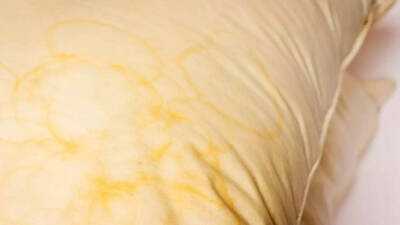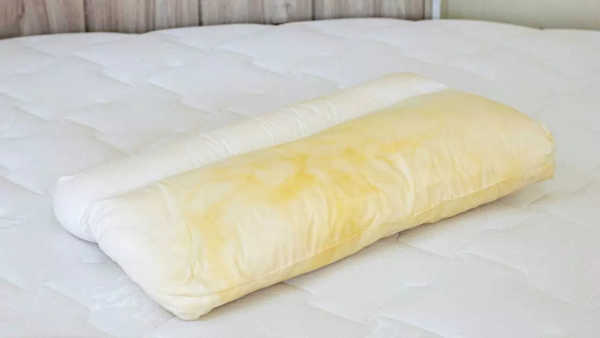
Yellow stains on pillows are a common issue that many people overlook, but they can reveal important information about your health and sleep habits. These stains usually result from the natural buildup of sweat, body oils, saliva, dead skin cells, and residues from hair or skincare products. Over time, this accumulation not only discolours your pillow but can also create a warm, moist environment that encourages the growth of bacteria and dust mites. Understanding why these stains appear and taking steps to prevent and clean them is essential for maintaining pillow hygiene , protecting your health, and ensuring a restful night’s sleep.
Yellow pillow stains: The hidden health warning you can’t ignore

Noticing yellow stains on your pillow can be unsettling, but these marks often reveal more than just aesthetic issues. Yellowing typically occurs over time as sweat, body oils, saliva, and dead skin cells seep into the pillow’s fabric. Hair products, skincare residue, and even natural body secretions can further contribute to discolouration. While pillowcases offer some protection, the pillow itself can absorb these substances, creating noticeable yellow spots. Beyond appearance, these stains can indicate moisture buildup and the potential growth of bacteria, making them an important sign to pay attention to.
Common causes of pillow discoloration while you sleep
- Nighttime sweat: Sweat released during sleep seeps into the pillow fabric and filling.
- Body oils: Natural oils from your skin mix with sweat and contribute to discoloration.
- Dead skin cells: Shedding skin accumulates on the pillow surface over time.
- Hair products residue: Shampoos, conditioners, and styling products can leave marks.
- Skincare residues: Lotions, creams, and serums applied before bed may stain pillows.
- Saliva and bodily fluids: Minor drooling or other fluids can seep into the pillow.
- Moisture buildup: Combined effects create a damp environment that promotes yellowing.
Health risks of using yellowed or stained pillows
Using a pillow with yellow stains may increase your exposure to allergens and bacteria. Dust mites and microbes thrive in the warm, moist environment created by sweat and oils. This can trigger allergic reactions, aggravate asthma, or worsen other respiratory conditions. A
study published in NIH found a diverse range of fungal spores inside typical used pillows, some of which are linked to respiratory infections. Accumulated oils and dead skin can also contribute to skin irritation or acne flare-ups. Even minor stains can indicate bacterial presence, so maintaining pillow hygiene is crucial. Addressing these stains promptly not only preserves the pillow’s appearance but also safeguards your health and ensures a cleaner, safer sleeping environment.
Simple ways to prevent yellow stains on pillows
Use pillow protectors or waterproof covers to create a barrier against sweat, oils, and other fluids.
Change pillowcases regularly, ideally once a week, to limit the buildup of dead skin and oils.
Air out pillows daily to allow moisture to evaporate and keep them fresh.
Fluff pillows regularly to redistribute fillings and reduce damp spots.
Practice these habits consistently to maintain pillow cleanliness, prevent yellow stains, and extend pillow lifespan.
These steps also contribute to better sleep hygiene and overall comfort.
Effective methods to clean and restore stained pillows
If your pillows have already yellowed, there are several ways to restore them. Washing pillows according to their care label is usually effective for minor stains. For more stubborn yellowing, a solution of hydrogen peroxide diluted with water (1:5 ratio) can pre-treat the stains. Alternatively, a mixture of vinegar and water (1:3 ratio) can lift tough discoloration. Sun-drying pillows not only removes moisture but also helps naturally disinfect them with ultraviolet light. Heavily stained or old pillows should be replaced every one to two years to maintain optimal hygiene and comfort.
How to choose the right pillow for hygiene and comfort
Selecting the right pillow is essential for both sleep quality and hygiene. Hypoallergenic materials, such as memory foam or latex, help resist dust mites and bacterial growth. Choose a pillow with the right firmness to support your preferred sleeping position and maintain proper spinal alignment. Pillows with good breathability prevent moisture buildup, and washable designs make cleaning easier. Combining a high-quality pillow with protective covers ensures a fresh, clean sleeping environment while reducing the likelihood of yellow stains and related health risks.
Maintaining clean pillows goes hand in hand with overall sleep hygiene. Regularly inspecting your pillows for stains, airing them out, and washing or replacing them when necessary can significantly improve both comfort and health. Simple preventive measures, such as using pillow protectors and washing pillowcases weekly, help minimize sweat and oil buildup. Addressing yellow stains promptly not only preserves the pillow’s appearance but also reduces exposure to allergens and bacteria. By taking these steps, you can enjoy a healthier, more comfortable sleep environment while extending the life of your pillows.
Also Read:
6 best flowers to attract hummingbirds: Nectar-rich plants for your garden
 Yellow stains on pillows are a common issue that many people overlook, but they can reveal important information about your health and sleep habits. These stains usually result from the natural buildup of sweat, body oils, saliva, dead skin cells, and residues from hair or skincare products. Over time, this accumulation not only discolours your pillow but can also create a warm, moist environment that encourages the growth of bacteria and dust mites. Understanding why these stains appear and taking steps to prevent and clean them is essential for maintaining pillow hygiene , protecting your health, and ensuring a restful night’s sleep.
Yellow stains on pillows are a common issue that many people overlook, but they can reveal important information about your health and sleep habits. These stains usually result from the natural buildup of sweat, body oils, saliva, dead skin cells, and residues from hair or skincare products. Over time, this accumulation not only discolours your pillow but can also create a warm, moist environment that encourages the growth of bacteria and dust mites. Understanding why these stains appear and taking steps to prevent and clean them is essential for maintaining pillow hygiene , protecting your health, and ensuring a restful night’s sleep.
